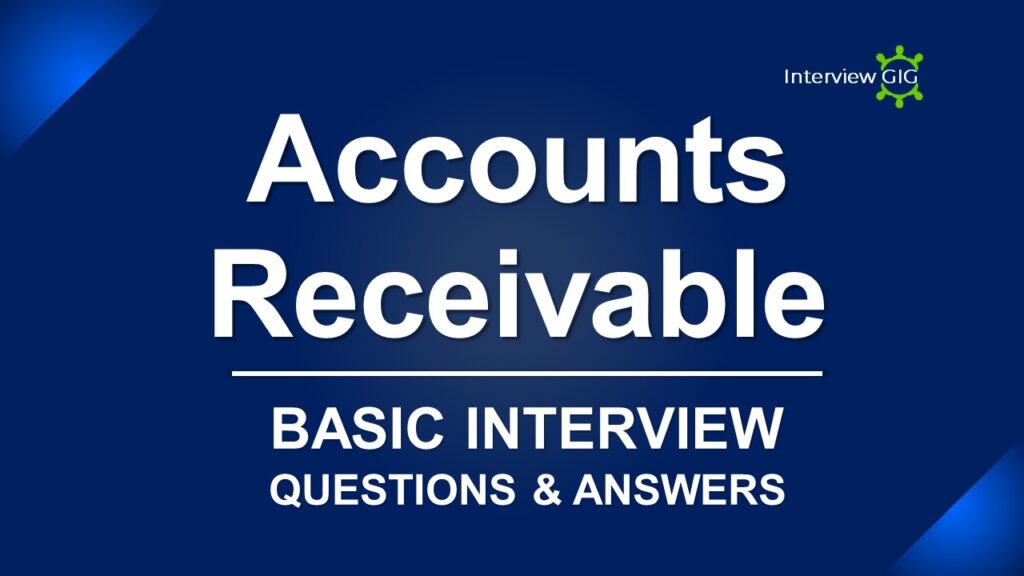Accounts Receivable Interview
Accounts Receivable (AR) represents the money owed to a business by its customers for goods or services delivered but not yet paid for. It’s essentially a short-term loan your company extends to customers when you allow them to purchase on credit.
Key Points about AR:
- Balance Sheet: AR is categorized as a current asset on a company’s balance sheet, meaning it’s expected to be collected within a year.
- Credit Sales: AR is created whenever a credit sale occurs. This could be when a customer makes a purchase on account or uses a credit card.
- Management Importance: Efficient AR management is crucial for a company’s financial health. It ensures a steady cash flow and minimizes the risk of bad debts.
Before your upcoming job interview, take a moment to review our meticulously prepared collection of the most frequently asked Accounts Receivable interview questions and comprehensive answers, specially crafted for freshers. This resource is tailored to equip you with the knowledge and confidence needed to tackle any AR-related inquiry during your interview.
Accounts Receivable Interview Questions for Experienced
Question: What do you know about Accounts Receivable?
Answer: Accounts Receivable, or AR, refers to the money owed by a company’s customers for goods or services they’ve already received but haven’t paid for yet. It’s essentially an IOU (I Owe You) from the customer’s perspective. In accounting terms, it’s considered a current asset on the company’s balance sheet, representing the claim to future cash inflow. Managing accounts receivable involves invoicing customers, tracking payments, following up on overdue balances, and reconciling accounts.
Question: Why are you interested in Accounts Receivable?
Sample Answer: I’m interested in Accounts Receivable because it offers an opportunity to work at the intersection of finance and customer relations. Managing AR requires attention to detail, problem-solving skills, and effective communication with both internal and external stakeholders. I am drawn to the dynamic nature of AR, where I can contribute to improving cash flow, reducing outstanding balances, and maintaining strong relationships with customers.
Question: Can you explain the Accounts Receivable process?
Answer: The Accounts Receivable process involves several steps:
- Invoicing: After goods or services are delivered to customers, invoices are generated and sent out promptly.
- Payment Terms: Clear payment terms are communicated to customers, specifying due dates, payment methods, and any applicable discounts or penalties.
- Payment Receipt: Payments received from customers are recorded in the accounting system, and invoices are marked as paid.
- Follow-up: If payments are not received by the due date, reminders are sent to customers through email, phone calls, or letters.
- Dispute Resolution: Any disputes regarding invoices are addressed promptly through communication with the customer and resolution of the issue.
- Aging Analysis: Regular review of aging reports helps identify overdue accounts and prioritize collection efforts.
- Cash Reconciliation: Accounts Receivable balances are reconciled with bank statements and general ledger accounts to ensure accuracy and completeness.
Question: What steps do you take to follow up on outstanding balances?
Steps to Follow Up on Outstanding Balances:
Answer: To ensure timely collections, I would follow a professional and graduated approach:
- Initial Reminder: Upon noticing an overdue payment, I’d send a courteous email reminding the customer of the outstanding balance and due date.
- Phone Call: If the email doesn’t prompt a response, I’d initiate a friendly phone call to discuss the overdue amount and offer payment options if available.
- Escalation: If the phone call remains unsuccessful, I’d escalate the issue to a supervisor for further action, which might involve sending a formal past-due notice or implementing stricter collection procedures according to company policy.
- Communication Throughout: Throughout the process, I’d maintain clear and open communication with the customer, addressing any inquiries and working towards a resolution.”
Question: What types of financial reports do you prepare related to accounts receivable?
Answer: I understand the importance of generating accurate and insightful reports to monitor AR health. Some key reports I’d be familiar with include:
- Accounts Receivable Aging Report: This report categorizes customer balances by their due date, highlighting overdue payments and potential bad debts.
- Days Sales Outstanding (DSO): This metric calculates the average number of days it takes a company to collect payments after a sale. It helps assess the efficiency of the collection process.
- Customer Payment History Report: This report provides a detailed breakdown of individual customer payment patterns, allowing for targeted collection efforts.
By analysing these reports, I can identify areas for improvement and contribute to developing strategies for optimizing AR performance.”
Question: How do you ensure successful collection from customers?
00Answer: Establish clear payment terms and communicate them effectively.
- Regularly review aging reports to identify overdue accounts and prioritize follow-up.
- Provide excellent customer service to address any concerns or disputes promptly.
- Utilize automation and software tools for efficient invoicing and payment tracking.
- Implement credit policies to assess customer creditworthiness and minimize risks of non-payment.
Question: Can you walk me through the steps you take to generate and send out invoices to customers?
Answer:
- Gather all necessary information including customer details, products or services provided, quantities, prices, and any applicable taxes or discounts.
- Use accounting software or templates to create the invoice, ensuring accuracy of all details.
- Assign a unique invoice number and include clear payment terms specifying due date, payment methods, and any late fees.
- Review the invoice for accuracy and completeness before sending it to the customer via email, mail, or electronic invoicing platforms.
- Keep a record of the invoice in the accounting system for tracking purposes and follow up as necessary to ensure timely payment.
Question: Explain the process of reconciling accounts receivable?
Answer: Maintaining accurate AR records is crucial. Here’s how I approach reconciliation:
- Periodic Review: I’d regularly compare the AR sub-ledger in the accounting system with bank statements and customer payment records.
- Identifying Discrepancies: Any inconsistencies, like unmatched deposits or missing payments, would be investigated and resolved promptly.
- Communication & Adjustments: If discrepancies arise, I’d communicate with the customer or relevant departments (sales, banking) to identify the root cause and make necessary adjustments to the AR records.
- Documentation: Throughout the process, I’d document all actions taken for future reference and audit purposes.”
Question: How would you handle a situation where a customer disputes an invoice?
Answer: “If a customer disputes an invoice, I’d follow these steps to maintain professionalism and resolve the issue effectively:
- Active Listening: I’d first actively listen to the customer’s concerns to understand the nature of the dispute.
- Reviewing Records: I’d then review relevant records (sales order, invoice details, communication history) to verify the invoice’s accuracy.
- Collaboration: If a discrepancy exists, I’d collaborate with the customer and potentially sales or other departments to reach a mutually agreeable solution. This might involve correcting the invoice or providing additional explanations.
- Clear Communication: Throughout the process, I’d maintain clear and professional communication with the customer, keeping them informed of the progress and resolution.”
Question: What defines effective collection in accounts receivable management?
Answer: Effective collection in accounts receivable management is defined by:
- Timely receipt of payments from customers within specified payment terms.
- Minimization of outstanding balances and reduction of Days Sales Outstanding (DSO).
- Regular monitoring and follow-up on overdue accounts to prioritize collections efforts.
- Implementation of efficient invoicing and payment processing systems to streamline the collection process.
- Maintenance of positive relationships with customers while ensuring adherence to credit policies and collection procedures
Question: Why are accounts receivable considered a current asset on the balance sheet?
Answer: Accounts receivable is considered a current asset because they represent amounts owed to the company by customers for goods or services provided within a short time frame, typically less than one year. Current assets are assets that are expected to be converted into cash or used up within the operating cycle of the business, which usually extends up to one year. Since accounts receivable are expected to be collected in the near future, they are classified as a current asset on the balance sheet.
Question: What are the primary objectives or goals of managing accounts receivable?
Answer: The primary objectives of managing accounts receivable include:
- Maximizing cash flow by accelerating the collection of receivables.
- Minimizing bad debts and reducing the risk of non-payment.
- Optimizing working capital by efficiently converting accounts receivable into cash.
- Maintaining positive customer relationships through effective communication and resolution of disputes.
- Monitoring and improving the efficiency of the accounts receivable process to reduce administrative costs.
Question: What does the accounts receivable turnover ratio measure?
Answer: The Accounts Receivable Turnover Ratio measures how efficiently a company collects its outstanding debts. It calculates how many times, on average, a company sells and collects payment for its goods or services within a specific period (usually a year). A higher ratio indicates faster collection and potentially better AR management.
Question: What steps do you take after receiving payment from a customer to finalize the transaction?
Answer: After receiving payment from a customer, the following steps are typically taken to finalize the transaction:
-
- Record the payment in the accounting system, updating the customer’s account to reflect the payment received.
- Allocate the payment to the appropriate invoice(s) or account(s) receivable.
- Issue a receipt or acknowledgment to the customer confirming the payment.
- Reconcile the accounts receivable ledger with the general ledger to ensure accuracy and completeness.
- Follow up with the customer to resolve any outstanding issues or discrepancies related to the payment.
- Close the transaction by updating relevant reports and documentation to reflect the payment received.
Question: How is the AR turnover ratio calculated, and what does it indicate about a company’s operations?
Answer: The accounts receivable turnover ratio is calculated by dividing net credit sales by the average accounts receivable balance during a specific period.
The formula is:
Accounts Receivable Turnover Ratio=Net Credit Sales/Average Accounts Receivable
- Net Credit Sales: Total sales on credit minus sales returns and allowances.
- Average Accounts Receivable: (Beginning AR Balance + Ending AR Balance) / 2
This ratio indicates how efficiently a company collects payments from its customers. A higher turnover ratio suggests that the company is collecting payments quickly, which is typically favourable as it indicates effective credit policies, strong collection efforts, or favourable customer payment behaviour. Conversely, a lower turnover ratio may indicate issues with credit policies, collection efforts, or slower customer payments.
Question: What does DSO represent in accounts receivable management?
Answer: Days Sales Outstanding (DSO) is another crucial metric in AR management. It calculates the average number of days it takes a company to collect payment after a sale is made. Here’s the formula and its significance:
- Formula: DSO = Average Accounts Receivable / Net Credit Sales (in days) x 365
- A lower DSO indicates faster collections and better cash flow management. A higher DSO suggests slower collections, potentially impacting cash flow and raising concerns about bad debt risk.
Question: What is the provision for doubtful debts, and why is it necessary in accounts receivable management?
Answer: The provision for doubtful debts, also known as allowance for doubtful accounts, is an estimate of the amount of accounts receivable that may not be collected due to customer defaults, insolvencies, or other factors. It is necessary in accounts receivable management to account for the risk of non-payment and to accurately reflect the true value of accounts receivable on the balance sheet. By establishing a provision for doubtful debts, companies can better match revenues with expenses and provide a more accurate picture of their financial position.
Question: How is DSO calculated, and what does it signify about a company’s collections efficiency?
Answer: DSO is calculated by dividing the average accounts receivable balance by the average daily credit sales. The formula is:
Days Sales Outstanding = (Accounts Receivable/Net Credit Sales)x Number of days.
DSO signifies how long it takes, on average, for a company to collect payments from its customers. A lower DSO indicates that the company is collecting payments more quickly, which is generally indicative of efficient collections processes. Conversely, a higher DSO suggests that payments are taking longer to collect, which may indicate inefficiencies in collections efforts or issues with customer payment behaviour.
Question: What is an AR aging report, and why is it important in accounts receivable management?
Answer: An AR aging report is a financial document that categorizes accounts receivable balances based on the length of time they have been outstanding. It typically divides receivables into aging buckets such as current, 30 days, 60 days, 90 days, and over 90 days past due. This report is important in accounts receivable management because it provides a clear snapshot of the company’s outstanding receivables and helps identify overdue accounts that require immediate attention. It enables businesses to prioritize collection efforts, track payment trends, and assess the effectiveness of credit and collection policies.
Question: What information does an aging report provide in accounts receivable management?
Answer: An aging report provides the following information in accounts receivable management:
- The total outstanding accounts receivable balance.
- The breakdown of receivables by age categories (e.g., current, past due 30 days, 60 days, 90 days, etc.).
- The specific customers and amounts owed within each age category.
- The total amount of overdue receivables and the percentage of total receivables that are past due.
- Insights into the company’s collections performance and potential areas for improvement.
Question: How is the average credit period calculated, and why is it significant for assessing credit policies?
Answer: The Average Credit Period (ACP) is a metric that measures the average time it takes a company to collect payment for its credit sales. Here’s the formula and its significance:
- Formula: ACP = DSO x 365 / Number of Credit Sales per Day
A lower ACP indicates faster collections and better cash flow management. A higher ACP suggests slower collections, potentially impacting cash flow and raising concerns about bad debt risk. It also helps assess the effectiveness of a company’s credit policy.
Assessing Credit Policy: If the ACP is significantly higher than the established credit terms (e.g., net 30 days), it suggests customers are taking longer to pay than expected. This could indicate a need to tighten credit controls or improve collection procedures.
Question: What steps would you take to collect an overdue payment?
Answer: To collect an overdue payment, I would take the following steps:
- Send polite reminders to the customer via email, phone calls, or letters, clearly stating the overdue amount and payment deadline.
- Offer flexible payment options or negotiate a payment plan if necessary.
- Escalate the matter by sending formal demand letters or involving a collections agency if the payment remains outstanding.
- Document all communication and actions taken for future reference.
- Regularly follow up with the customer until the payment is received or a resolution is reached.
Question: What distinguishes current assets from contingent assets?
Answer:
Current assets are resourcing a company expects to convert into cash within one year or the operating cycle, whichever is longer. They are readily available to meet short-term financial obligations. Examples include cash, accounts receivable, and inventory.
Contingent assets, on the other hand, are potential future economic benefits that depend on the occurrence of a specific event. The company may or may not acquire these benefits. Examples include lawsuits with a favorable outcome, potential claims for insurance recoveries, or potential tax refunds.
Question: What constitutes “service rendered” in the context of accounts receivable?
Answer: Service rendered” in the context of accounts receivable refers to the completion of services or delivery of goods to a customer as per the terms of a contractual agreement. It signifies that the company has fulfilled its obligation to provide products or services to the customer, and the customer is now obligated to make payment for the rendered service or delivered goods.
Question: What are delinquent accounts within accounts receivable, and why are they a concern?
Answer: Delinquent accounts in AR represent outstanding balances that have surpassed the agreed-upon payment terms. These are a concern for several reasons:
- Reduced Cash Flow: Delinquent accounts delay the inflow of cash, potentially impacting the company’s ability to meet its own financial obligations.
- Increased Bad Debt Risk: The longer an account remains delinquent, the higher the risk of the debt becoming uncollectible, ultimately leading to a write-off as bad debt.
- Negative Impact on Customer Relationships: Unresolved delinquencies can strain customer relationships and potentially harm the company’s reputation.
Question: Can past due invoices be collected, and if so, what strategies are typically employed?
Answer: Yes, past due invoices can be collected through various strategies, including:
- Sending reminder notices and follow-up communications to prompt payment.
- Offering incentives for early payment or negotiating payment plans.
- Utilizing automated payment reminders and collection software.
- Escalating collection efforts with formal demand letters or involving collection agencies.
- Reviewing and updating credit policies to minimize future delinquencies.
Question: How do you approach the collection of overdue invoices while maintaining customer relationships?
Answer: Approach the collection of overdue invoices by:
- Maintaining open and respectful communication with customers.
- Understanding and addressing any issues or challenges causing payment delays.
- Offering flexible payment options or accommodations based on the customer’s circumstances.
- Providing exceptional customer service and support throughout the collection process.
- Emphasizing the importance of timely payment while preserving the customer’s goodwill and loyalty.
Question: At what point does the accounts receivable process conclude, and what actions are taken to wrap up outstanding transactions?
Answer: The accounts receivable process concludes when all outstanding invoices have been collected, reconciled, and closed. Actions taken to wrap up outstanding transactions include:
- Confirming receipt of payment and updating the accounts receivable ledger.
- Closing out invoices and marking them as paid in the accounting system.
- Reconciling accounts receivable balances with the general ledger.
- Reviewing and addressing any remaining discrepancies or unresolved issues.
- Generating final reports and documentation for financial reporting and audit purposes.





